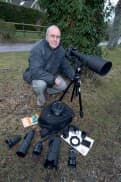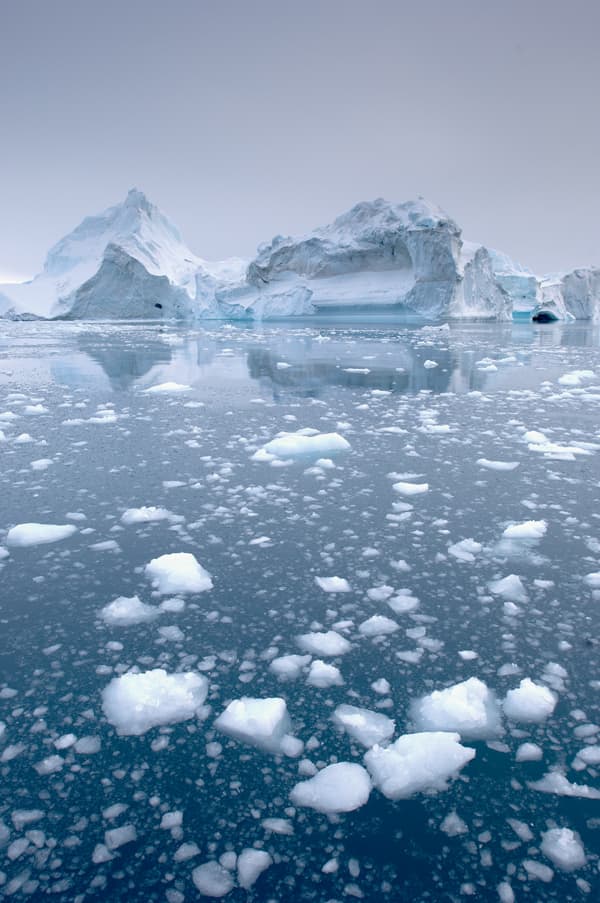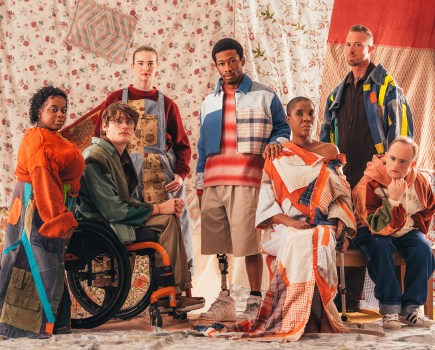
This image was shot on a farm in Australia. Captured as a stock photo to illustrate global warming, it was taken with a Nikon D2x using a 16mm fisheye.
 It was actually with the esteemed editor of What Digital Camera that landscape photographer Jeremy Walker first kicked off his interest in photography. Both he and Nigel Atherton were at school together, and, rather than indulge in the complexities of maths, they found it much more fun to talk about the fascinating world of cameras and photography. This was at Frome College in Somerset. Jeremy takes up the tale.
It was actually with the esteemed editor of What Digital Camera that landscape photographer Jeremy Walker first kicked off his interest in photography. Both he and Nigel Atherton were at school together, and, rather than indulge in the complexities of maths, they found it much more fun to talk about the fascinating world of cameras and photography. This was at Frome College in Somerset. Jeremy takes up the tale.
‘I’d finished my fifth year,’ said the 43-year-old photographer from the West Country, and had stayed on to repeat some O Levels. But photography was my first love and from the first moment I picked up a camera at school, I was hooked.’
Although Jeremy was something of a natural when it came to photography, he was very aware that he would need some guidance from an expert hand if he was to reach the heights he wanted to.
‘I approached Peter Lowry, one of the UK’s top wedding and portrait photographers, and asked if I could join him as an assistant.’ Said Jeremy Walker. ‘Unfortunately he said no, but he did say I could go and see him and learn what I could every now and again – I picked up a huge amount and it was incredibly beneficial.
‘I then went to Somerset College and from there, went to Gloucester and Cheltenham College of Art, where I studied photography. I was at the latter college for three years, and upon qualifying, then went on to assist Chris Overton in London. This was followed by intermittent freelancing before I went to assist JP Froget. JP was a massive influence on my photography career and life, and I gleaned a huge amount from my time with him. He was a London advertising photographer and did pretty much everything – it was the perfect way for me to pick up different aspects of photography.
 ‘After my spell with JP, I moved away to run a commercial studio for a print and design company. From one job a week, this progressed rapidly to work seven days a week within a year. Work came in with Formula 1, through Mercedes, and there was lots of shoe-related photography, aerial photography, and Avon cosmetics commissions, among many more. I was there for five years but had a real yearning to do more location work so left and started taking stock pictures for Tony Stone images. I had a lot of friends who were shooting stock shots, and thus combined my stock photography with commercial work.
‘After my spell with JP, I moved away to run a commercial studio for a print and design company. From one job a week, this progressed rapidly to work seven days a week within a year. Work came in with Formula 1, through Mercedes, and there was lots of shoe-related photography, aerial photography, and Avon cosmetics commissions, among many more. I was there for five years but had a real yearning to do more location work so left and started taking stock pictures for Tony Stone images. I had a lot of friends who were shooting stock shots, and thus combined my stock photography with commercial work.
‘The obvious incentive was to make money, so I basically did anything that would pay. But my main love was landscapes and that’s where I am now, and six years ago I moved back to the West Country.
‘From a business point of view, I’d been fairly self-disciplined from my early photography work but it was JP who really taught me about running your own enterprise. He was such a brilliant businessman and was quite prepared to impart his knowledge on the subject whenever he could.’
In terms of camera equipment, Jeremy Walker kicked off with Nikon and has remained with them ever since. ‘I left college in 1985,’ said Jeremy, ‘and had a Nikon F2A. This has now zipped forward to a Nikon D2X today, and there are aspirations to get a Nikon D3 in the not-too-distant future.

This image was captured as a stock photo to illustrate global warming, it was taken with a Nikon D2x using a 16mm fisheye
‘Even though some people quickly opted for Canon in the digital revolution. I stuck with Nikon. There’s more to life than megapixels. It’s the useability of Nikon that really makes it stand out – when I pick it up, all the buttons are exactly where I want them. Then there’s the ruggedness – Nikon bodies are robust and more than up to the tasks I ask of them. I also find the optical quality of Nikkor lenses second-to-none.’
But what does the future hold for a man who has already acheived a lot in the world of photography – both in a personal and professional way? ‘It would seem that the stock image market is falling flat on its face,’ said Jeremy. ‘The industry is changing rapidly and it’s not like it once was, so, although I’ll still do this sort of work, it’s not where the future lies. But in terms of what I want to do personally, I’d certainly like to write a book. Not so much a ‘how to’ book, more of a coffee table read, something showcasing my work. I’ve been to a publisher, and hopefully something will materialise. I can also see myself doing more commercial work – especially architecture, which has always been a huge passion of mine. Even though people opted for Canon, I stuck with Nikon.
Landscape photographer Jeremy Walker Profile – Jeremy’s Kit
 Here’s a breakdown of what’s inside Jeremy Walker’s kit bag.
Here’s a breakdown of what’s inside Jeremy Walker’s kit bag.
Nikon D2X
Jeremy has two Nikon D2X bodies, illustrating his loyalty to this camera. The robust nature of the camera bodies, and the technical excellence of Nikon, all make this the perfect brand in his eyes. www.nikon.com
Nikkor 17-35mm f/2.8
This lens comes into its own for landscapes and produces stunning images. The focal range is perfect for the wide landscapes shots I’m after.
Nikkor 300mm f/4
This allows for some great long shots, and gives me the reach for the shots that the 80-200mm isn’t close enough for.
Lowe Pro Mini Trekker AW
Lowe Pro are a well known and trusted brand, and it’s no secret that when you buy one of their products, you won’t be disappointed. This bag is the perfect item to carry my kit in, and can easily hold a D2X body, and my 17-35mm, 35-70mm, 80-200, and 300mm lenses. www.lowepro.com
Nikkor 35-70mm f/2.8
This is a great mid-range lens, and offers a good number of options when I’m out taking shots. It’s an f/2.8 as well.
Nikkor 80-200mm f/2.8
This is a very popular lens, and has many fans. I use it a lot, and it’s the kind of lens that is very versatile, allowing for certain landscape shots and close-up shots on wildlife.
Nikkor 500mm f/4 D
This is the ‘big boy’ of the kit, but doesn’t make that many appearances.
Lee Filters
Because I’m often shooting landscapes, I’ll make good use of filters to get the shots I want. These will include some ND filters and a polarising filter.
Back-up and More Kit
I always have a second bag as back-up in the car. It has my other Nikon D2X body in, and some spare lenses that I wouldn’t necessarily use but might come in handy on the off-chance. I have a range of other kit and lenses as well, and these include the following:
- Schneider 28mm PC
- 16mm f/2.8 fisheye
- 105mm f/2.8 micro
- Nikon SB800
- MC30 cable release
- Spare battery card holder
- 1.4x convertor
Manfrotto 055B Tripod
When it comes to tripods, I’ve got a Manfrotto 055B, topped off by a Linhoff ball and socket. A tripod is an essential part of a landscape photographer’s kit, if not all photographers.
 Lexar 4GB Card
Lexar 4GB Card
My storage comes in the form of Lexar 2GB and 4GB cards – in all I have about 40GB of memory cards. I’ve also got an Epson P2000 40GB device, great for when you’re out and about. If it came down to a laptop, I’d consider an Apple if it re-introduced the 12in screen version.
Cleaning Kit
It’s a popular one with photographers, and is popular with me – the Arctic butterfly.
Clothing
In terms of clothing, I’ll definitely choose wisely and tailor it to the weather conditions, and, with that in mind, it’s usually a choice of two jackets – my North Face Arctic proof parka, or my traditional Barbour jacket: it’s warm and robust, and has served me well over the years.
 Compass, and pad and pen
Compass, and pad and pen
One of the most important things in my bag is a compass – this is perfect for determining sunrise and sunsets, and allows me to position myself perfectly. I’ll also never leave home without a pad or pen. Not only does this let me jot down information on a particular shot I’ve taken, but it also gives me the option to write down ideas that pop into my head while I’m on a shoot.
Jeremy Walker Profile – Jeremy’s Gallery
Although landscape is Jeremy Walker’s first love, you will find more than merely countryside compositions appearing in his portfolio. Indeed, architecture is a real passion of his, as demonstrated by this shot of the London Mayor’s office and London Bridge below.








